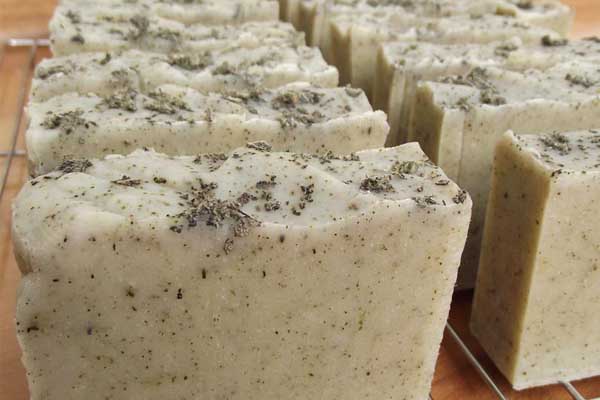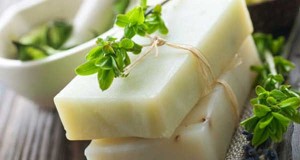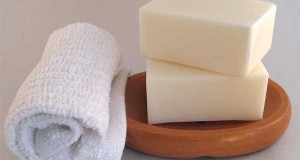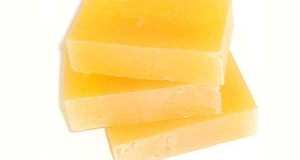Sandalwood and Sage Soap
in Soap Recipes
October 29, 2013
45369 Views
Ingredients
- 20 ounces of olive oil
- 15 ounces of coconut oil
- 15 ounces of palm oil
- 15 ounces of distilled water
- 7.25 ounces lye
- 1 TBSP Sandalwood oil
- 2 TBSP Dry Sage Herb
Instructions
- First you will want to get all of your ingredients and supplies gathered together. You don’t want to have to stop in the middle of a recipe to go find a spoon, spatula or ingredient you forgot to gather up, so check and double check that you have everything you will need.
- Once you’ve got everything assembled, you can begin measuring your ingredients. It is best to start with your lye and water measurements.
- Measure the lye and water in two separate containers, and then add the LYE to the WATER. NEVER try to add the water to the lye, or you could end up with serious injuries!
- After adding the lye to the water, stir gently for several minutes or until all the lye is dissolved. Stir in a constant speed and motion to avoid clumping. Once all lye is dissolved, measure the temperature of the solution. It will probably be above 100 degrees already, so place it in the ice bath while you measure out your other ingredients.
- Measure in a stainless steel pot, and use the TARE function on the scale to zero it out after putting the pot on the scale, and then after measuring one oil and before the other. This way you know you have measured exactly as much of each oil that you need.
- Put the pot of hard oils on the stove on a medium heat and let them melt for a couple of minutes. Then go back to your lye solution and check the temperature. Remember we want it around 100 degrees. If it is lower than that, take it out of the bath.
- While you allow the hard oils to melt, measure out your liquid oils. In this recipe the only liquid oils you are using is Olive Oil. Once you have these measured out, your hard oils should be close to done. Even if there are tiny chunks still in the pan, take it off the heat. Stir for about 1 – 2 more minutes, then add your liquid oils to the pan and stir gently.
- Leave the pan of oils to cool in the ice bath and measure your herbs and essential oils out. This recipe is sandalwood sage, a very musky masculine soap, so you will be adding the sandalwood oil and the sage herb. After you’ve measured these out in separate containers, check your oils in the pan to be sure they are around 100 degrees.
- If the oils and lye solution are right around the same temperature, you can begin to slowly drizzle the lye solution into the oils. Stir slowly and constantly during this step and add SLOWLY so as to keep the soap consistent and avoid splashes.
- After pouring all of your lye solution into your oils, switch to the stick blender. Using a stick blender takes the amount of time to reach trace from about 15 – 30 mins to around 2 mins, so I recommend using one.
- Use the stick blender on a medium speed and move it in figure 8 shapes until you reach trace. Check for trace at the 2 minute mark and every thirty seconds after that. Trace is defined by lifting the blender out of the soap and swirling it slowly. If the dripping soap leaves trails on the surface in the pan, then you’ve reached trace.
- Now you can add your essential oils and herbs. It’s important not to add them before this because they will lose their scent and benefits quickly in a hot soap solution. Add them in and stir for a few more seconds with the stick blender.
- Once you’ve mixed your herbs and essential oils, it’s time to pour the soap into the mold.
- Now it’s time to cover the soap with a towel and set it aside. Leave it to cure for 24 – 48 hours. Do not uncover the soap before 24 hours!
- After a day, uncover it to check the firmness. You want it to be just soft enough that you can make a slight indent with your finger and a bit of pressure. If this has not been achieved after 24 hours, cover the soap again and wait another day. Once you have reached this firmness, take the soap out of the mold and unwrap it.
- Now you can cut the soap into individual bars. You are ready to put them on a wire rack and place them somewhere out of the way to finish curing. This will take at least 2 weeks, and generally more like 4 – 6. After the soap has completely cured, you can wrap it up, use it, gift it, or even sell it.
hot process soap sandalwood and sage soap 2013-10-29
 Start Soap Making Enjoy the process, Reap the Benefits and Beautify With Homemade Soap
Start Soap Making Enjoy the process, Reap the Benefits and Beautify With Homemade Soap





I love the scent of Sandalwood – can’t wait to try making this one